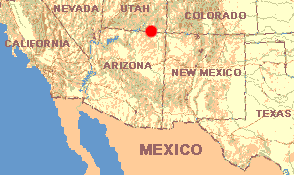 April 10, 1988
April 10, 1988UTAH: San Juan County
Between Oljato Trading Post and Gouldings Trading Post about seven miles west of junction of US Hwy. 163 and the Utah/Arizona state line; near Monument Valley and inside Navajo Indian Reservation
 April 10, 1988
April 10, 1988Three years ago I met the Harrises in Mexico and promised that someday I'd come for a visit. Diane Harris and her thirteen-year old son David live on southeastern Utah's Navajo Reservation. As soon as I see their home, designed and built by themselves and cluttered with fruit trees, a hand pump beside the well, an ancient land Rover and other items, and them smiling and welcoming me, I know that here I shall end this book. This place's warmth and spiritual ambiance is perfect to serve as a trail's end. The end comes suddenly, but unmistakably.
But, first, let me tell you about the Harrises' front yard. This morning Diane Harris gives me the cook's tour, beginning with an ankle-high, dark-leaved member of the Composite Family.
"This is Matchweed [Gutierrezia sarothrae]," she says. "I've heard some people call it Kerosineweed because it's so full of oil that sometimes you can set fire to its green leaves. Livestock won't eat it, which is why it's so common around here. And over here, this is our common yucca (It's the Fineleaf Yucca, Yucca angustissima, we met in Paria's highlands) and of course this is Rabbitbrush, [Ericamerica nauseosus]. In the summer Rabbitbrush gets just full of yellow flowers (It's a knee-high member of the Composite Family still bearing abundant clusters of last season's dried-up fruiting heads). This bush here is Saltbush [Atriplex canescens], which has interesting little four-winged fruits. It's a very fine plant for grazing animals, but lately it's been dying off around here and nobody knows why."
"Of course you've seen a lot of this Mormon Tea [genus Ephedra] and the Tumbleweed [Salsola kali]," she continues. " We used to make Tumbleweed soup out of the young sprouts, but it was hard to remove all the sand from the green shoots, so we stopped making it. And over here we have what the Navajos call Squawberry [Rhus trilobata]. Look: Scrape your thumbnail across the bark of its twig. Smell? Sometimes you walk into a Navajo family's hogan and if you smell this, you know that the women have been weaving baskets from Squawberry stems. In the summer the Squawberry bush produces bunches of dark red, sticky berries, which the Navajos often use in making 'lemonade.' I've made a very tart preserve from them and those fruits must be just full of Vitamin C. Finally, over here is Blackbush [Coleogyne ramosissima], which later will bear many yellow flowers. All of these plants grow here naturally; but we did put up the fence to keep our neighbors' sheep and cattle out, and that's why our yard is more lush-looking than the surrounding desert."
Besides these herbs and bushes, two main grasses are evident in the Harrises' front yard. Especially around the fruit trees, which regularly are watered, broad green splotches of densely clumped Downy Chess [Bromus tectorum] are growing. Though an "alien introduced from Europe," it's one of the most common and widespread of U. S. grasses. Usually it's considered a weed, especially because its florets bear needle-like awns that can puncture a grazing animal's soft mouthparts. A little less conspicuous than the Downy Chess is Indian Ricegrass [Oryzopsis hymenoides], which my books praise as a superior livestock forage grass. Bearing large and nutritious grains (about one quarter the size of a grain of store-bought brown rice), the Zuni Indians once used this plant as a food source for themselves.
Right now the Harrises' peach tree is absolutely filled with pink blossoms swarming with honeybees. Their big apricot tree already has passed its flowering peak and is littered below with brown, shriveled-up flowers, while on the branches immature apricots, about half an inch long and fuzzy, abound. Both the peach's and apricot's leaves are just beginning to expand from buds, and are no more than an inch long. A pear tree, too young to bear flowers, has leaves up to one inch long. Among the ornamental trees, the Black Locusts, Robinia pseudoacacia, look as if they're still back in the middle of winter, but the tree that Diane calls Siberian-pea, Caragana arborescens,a member of the Bean Family I've never seen, is decked out in inch-long, compound leaves and 3/4-inch yellow blossoms. A Russian-olive, Eleagnus angustifolia, bears leaves expanded to about half an inch.
All the way across Utah the junipers have been confusing me. Today I try to figure them out again, but to no avail. It's curious -- somehow I'm glad that I shall leave here with this problem unresolved.